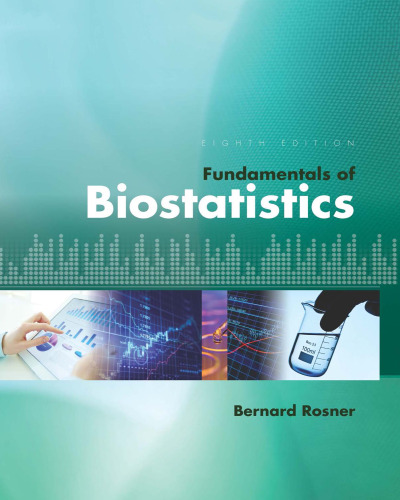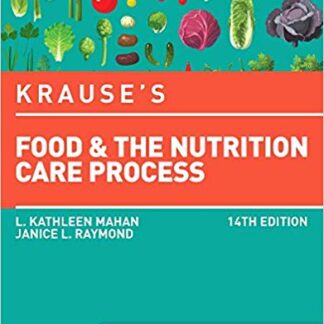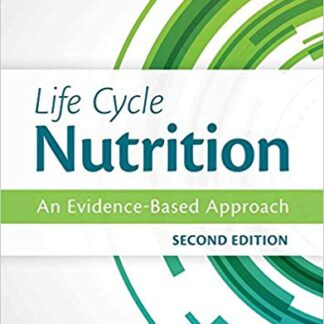Description
Fundamentals of Biostatistics 8th Edition by Bernard Rosner, ISBN-13: 978-1305268920
[PDF eBook eTextbook] – Available Instantly
- Publisher: Cengage Learning; 8th edition (August 3, 2015)
- Language: English
- 927 pages
- ISBN-10: 130526892X
- ISBN-13: 978-1305268920
Bernard Rosner’s FUNDAMENTALS OF BIOSTATISTICS is a practical introduction to the methods, techniques, and computation of statistics with human subjects. It prepares students for their future courses and careers by introducing the statistical methods most often used in medical literature. Rosner minimizes the amount of mathematical formulation (algebra-based) while still giving complete explanations of all the important concepts. As in previous editions, a major strength of this book is that every new concept is developed systematically through completely worked out examples from current medical research problems. Most methods are illustrated with specific instructions as to implementation using software either from SAS, Stata, R, Excel or Minitab.
Table of Contents:
Cover Page
Title Page
Copyright Page
Dedication
Preface
Acknowledgments
About the Author
Chapter 1. General Overview
Section Content
Chapter 2. Descriptive Statistics
2.1. Introduction
2.2. Measures of Location
The Arithmetic Mean
The Median
Comparison of the Arithmetic Mean and the Median
The Mode
The Geometric Mean
2.3. Some Properties of the Arithmetic Mean
2.4. Measures Of Spread
The Range
Quantiles
The Variance and Standard Deviation
2.5. Some Properties of the Variance and Standard Deviation
2.6. The Coefficient of Variation
2.7. Grouped Data
2.8. Graphic Methods
Bar Graphs
Stem-and-Leaf Plots
Box Plots
2.9. Case Study 1: Effects of Lead Exposure on Neurological and Psychological Function in Children
2.10. Case Study 2: Effects of Tobacco Use on Bone-Mineral Density in Middle-Aged Women
2.11. Obtaining Descriptive Statistics on the Computer
2.12. Summary
Problems
Chapter 3. Probability
3.1. Introduction
3.2. Definition of Probability
3.3. Some Useful Probabilistic Notation
3.4. The Multiplication Law of Probability
3.5. The Addition Law of Probability
3.6. Conditional Probability
Total-Probability Rule
3.7. Bayes’ Rule and Screening Tests
Bayes’ Rule
3.8. Bayesian Inference
3.9. ROC Curves
3.10. Prevalence and Incidence
3.11. Summary
Problems
Chapter 4. Discrete Probability Distributions
4.1. Introduction
4.2. Random Variables
4.3. The Probability-Mass Function for a Discrete Random Variable
Relationship of Probability Distributions to Frequency Distributions
4.4. The Expected Value of a Discrete Random Variable
4.5. The Variance of a Discrete Random Variable
4.6. The Cumulative-Distribution Function of a Discrete Random Variable
4.7. Permutations and Combinations
4.8. The Binomial Distribution
Using Binomial Tables
Using “Electronic” Tables
4.9. Expected Value and Variance of the Binomial Distribution
4.10. The Poisson Distribution
4.11. Computation of Poisson Probabilities
Using Poisson Tables
Electronic Tables for the Poisson Distribution
4.12. Expected Value and Variance of the Poisson Distribution
4.13. Poisson Approximation to the Binomial Distribution
4.14. Summary
Problems
Chapter 5. Continuous Probability Distributions
5.1. Introduction
5.2. General Concepts
5.3. The Normal Distribution
5.4. Properties of the Standard Normal Distribution
Using Normal Tables
Using Electronic Tables for the Normal Distribution
5.5. Conversion from an N ( μ , σ 2 ) Distribution to an N ( 0 , 1 ) Distribution
5.6. Linear Combinations of Random Variables
5.7. Normal Approximation to the Binomial Distribution
5.8. Normal Approximation to the Poisson Distribution
5.9. Summary
Problems
Chapter 6. Estimation
6.1. Introduction
6.2. The Relationship Between Population and Sample
6.3. Random-Number Tables
6.4. Randomized Clinical Trials
Design Features of Randomized Clinical Trials
6.5. Estimation of the Mean of a Distribution
Point Estimation
Standard Error of the Mean
Central-Limit Theorem
Interval Estimation
t Distribution
6.6. Case Study: Effects of Tobacco Use on Bone-Mineral Density (BMD) in Middle-Aged Women
6.7. Estimation of the Variance of a Distribution
Point Estimation
The Chi-Square Distribution
Interval Estimation
6.8. Estimation for the Binomial Distribution
Point Estimation
Interval Estimation—Normal-Theory Methods
Interval Estimation—Exact Methods
6.9. Estimation for the Poisson Distribution
Point Estimation
Interval Estimation
6.10. One-Sided Confidence Intervals
6.11. The Bootstrap
6.12. Summary
Problems
Chapter 7. Hypothesis Testing: One-Sample Inference
7.1. Introduction
7.2. General Concepts
7.3. One-Sample Test for the Mean of a Normal Distribution: One-Sided Alternatives
7.4. One-Sample Test for the Mean of a Normal Distribution: Two-Sided Alternatives
Using the Computer to Perform the One-Sample t Test
One-Sample z Test
7.5. The Relationship between Hypothesis Testing and Confidence Intervals
7.6. The Power of a Test
One-Sided Alternatives
Two-Sided Alternatives
Using the Computer to Estimate Power
7.7. Sample-Size Determination
One-Sided Alternatives
Sample-Size Determination (Two-Sided Alternatives)
Using the Computer to Estimate Sample Size
Sample-Size Estimation Based on CI Width
7.8. One-Sample χ 2 Test for the Variance of a Normal Distribution
7.9. One-Sample Inference for the Binomial Distribution
Normal-Theory Methods
Using the Computer to Perform the One-Sample Binomial Test (Normal Theory Method)
Exact Methods
Using the Computer to perform the One-Sample Binomial Test (Exact Version)
Power and Sample-Size Estimation
Using the Computer to Estimate Power and Sample Size for the One-Sample Binomial Test
7.10. One-Sample Inference for the Poisson Distribution
7.11. Case Study: Effects of Tobacco Use on Bone-Mineral Density in Middle-Aged Women
7.12. Derivation of Selected Formulas
Derivation of Equation 7.23
7.13. Summary
Problems
Chapter 8. Hypothesis Testing: Two-Sample Inference
8.1. Introduction
8.2. The Paired t Test
8.3. Interval Estimation for the Comparison of Means from Two Paired Samples
8.4. Two-Sample t Test for Independent Samples with Equal Variances
8.5. Interval Estimation for the Comparison of Means from Two Independent Samples (Equal Variance Case)
8.6. Testing for the Equality of Two Variances
The F Distribution
Using the Computer to Obtain Percentiles and Areas for the F Distribution
The F Test
Using the Computer to Perform the F Test for the Equality of Two Variances
8.7. Two-Sample t Test for Independent Samples with Unequal Variances
Using the Computer to Perform the Two-Sample t Test with Unequal Variances
8.8. Case Study: Effects of Lead Exposure on Neurologic and Psychological Function in Children
8.9. Estimation of Sample Size and Power for Comparing Two Means
Estimation of Sample Size
Using the Computer to Estimate Sample Size for Comparing Means from Two Independent Samples
Estimation of Power
Using the Computer to Estimate Power for Comparing Means from Two Independent Samples
8.10. The Treatment of Outliers
8.11. Derivation of Equation 8.13
8.12. Summary
Problems
Chapter 9. Nonparametric Methods
9.1. Introduction
9.2. The Sign Test
Normal-Theory Method
Using the Computer to Perform the Sign Test (Normal Theory Method)
Exact Method
9.3. The Wilcoxon Signed-Rank Test
Using the Computer to Perform the Wilcoxon Signed Rank Test
9.4. The Wilcoxon Rank-Sum Test
Using the Computer to Perform the Wilcoxon Rank Sum Test
9.5. Case Study: Effects of Lead Exposure on Neurological and Psychological Function in Children
9.6. Permutation Tests
Using the Computer to Perform a Permutation Test
9.7. Summary
Problems
Chapter 10. Hypothesis Testing: Categorical Data
10.1. Introduction
10.2. Two-Sample Test for Binomial Proportions
Normal-Theory Method
Contingency-Table Method
Significance Testing Using the Contingency-Table Approach
Using the Computer to Perform the Chi-Square Test for 2 × 2 Tables
10.3. Fisher’s Exact Test
The Hypergeometric Distribution
Using the Computer to Perform Fisher’s Exact Test for 2 × 2 Tables
10.4. Two-Sample Test for Binomial Proportions for Matched-Pair Data (McNemar’s Test)
Normal-Theory Test
Exact Test
Using the Computer to Perform McNemar’s Test for Correlated Proportions
10.5. Estimation of Sample Size and Power for Comparing Two Binomial Proportions
Independent Samples
Using the Computer to Estimate Sample Size and Power for Comparing Two Binomial Proportions
Paired Samples
Sample Size and Power in a Clinical Trial Setting
10.6. R × C Contingency Tables
Tests for Association for R × C Contingency Tables
Using the Computer to Perform the Chi-Square Test for r × c Tables
Chi-Square Test for Trend in Binomial Proportions
Using the Computer to Perform the Chi-Square Test for Trend
Relationship Between the Wilcoxon Rank-Sum Test and the Chi-Square Test for Trend
10.7. Chi-Square Goodness-of-Fit Test
Using the Computer to Perform the Chi-Square Goodness-of-Fit Test
10.8. The Kappa Statistic
Using the Computer to Estimate Kappa
10.9. Derivation of Selected Formulas
Derivation of Equation 10.17
10.10. Summary
Problems
Chapter 11. Regression and Correlation Methods
11.1. Introduction
11.2. General Concepts
11.3. Fitting Regression Lines—The Method of Least Squares
11.4. Inferences About Parameters from Regression Lines
F Test for Simple Linear Regression
Using the Computer to Perform the F Test for Simple Linear Regression
t Test for Simple Linear Regression
Using the Computer to Perform the t Test for Simple Linear Regression
11.5. Interval Estimation for Linear Regression
Interval Estimates for Regression Parameters
Interval Estimation for Predictions Made from Regression Lines
Using the Computer to Obtain Confidence Limits for Predictions from Linear Regression Models
11.6. Assessing the Goodness of Fit of Regression Lines
11.7. The Correlation Coefficient
Relationship Between the Sample Correlation Coefficient ( r ) and the Population Correlation Coefficient ( ρ )
Relationship Between the Sample Regression Coefficient ( b ) and the Sample Correlation Coefficient ( r )
11.8. Statistical Inference for Correlation Coefficients
One-Sample t Test for a Correlation Coefficient
Using the Computer to Perform the One-Sample t Test for Correlation
One-Sample z Test for a Correlation Coefficient
Interval Estimation for Correlation Coefficients
Using the Computer to Obtain Confidence Limits for a Correlation Coefficient
Sample-Size Estimation for Correlation Coefficients
Two-Sample Test for Correlations
11.9. Multiple Regression
Estimation of the Regression Equation
Hypothesis Testing
Criteria for Goodness of Fit
11.10. Case Study: Effects of Lead Exposure on Neurologic and Psychological Function in Children
11.11. Partial and Multiple Correlation
Partial Correlation
Multiple Correlation
11.12. Rank Correlation
11.13. Interval Estimation for Rank-Correlation Coefficients
11.14. Derivation of Equation 11.26
11.15. Summary
Problems
Chapter 12. Multisample Inference
12.1. Introduction to the One-Way Analysis of Variance
12.2. One-Way ANOVA—Fixed-Effects Model
12.3. Hypothesis Testing in One-Way ANOVA—Fixed-Effects Model
F Test for Overall Comparison of Group Means
Using the Computer to Perform One-Way ANOVA
12.4. Comparisons of Specific Groups in One-Way ANOVA
t Test for Comparison of Pairs of Groups
Linear Contrasts
Multiple Comparisons—Bonferroni Approach
Multiple-Comparisons Procedures for Linear Contrasts
The False-Discovery Rate
12.5. Case Study: Effects of Lead Exposure on Neurologic and Psychological Function in Children
Application of One-Way ANOVA
Relationship Between One-Way ANOVA and Multiple Regression
One-Way Analysis of Covariance
12.6. Two-Way Anova
Hypothesis Testing in Two-Way ANOVA
Two-Way ANCOVA
12.7. The Kruskal-Wallis Test
Using the Computer to Perform the Kruskal-Wallis Test
Comparison of Specific Groups Under the Kruskal-Wallis Test
12.8. One-Way ANOVA—The Random-Effects Model
12.9. The Intraclass Correlation Coefficient
Using the Computer to Estimate Intraclass Correlation
12.10. Mixed Models
12.11. Derivation of Equation 12.30
12.12. Summary
Problems
Chapter 13. Design and Analysis Techniques for Epidemiologic Studies
13.1. Introduction
13.2. Study Design
13.3. Measures of Effect for Categorical Data
The Risk Difference
The Risk Ratio
The Odds Ratio
Interval Estimation for the Odds Ratio
Using the Computer to Estimate the Risk Difference, Risk Ratio, and Odds Ratio
13.4. Attributable Risk
Using the Computer to Estimate Attributable Risk
13.5. Confounding and Standardization
Confounding
Standardization
13.6. Methods of Inference for Stratified Categorical Data—The Mantel-Haenszel Test
Estimation of the Odds Ratio for Stratified Data
Effect Modification
Estimation of the OR in Matched-Pair Studies
Using the Computer to Perform the Mantel-Haenszel Test and Estimate the Mantel-Haenszel Odds Ratio
Testing for Trend in the Presence of Confounding—Mantel-Extension Test
13.7. Multiple Logistic Regression
Introduction
General Model
Interpretation of Regression Parameters
Hypothesis Testing
Prediction with Multiple Logistic Regression
Assessing Goodness of Fit of Logistic-Regression Models
13.8. Extensions to Logistic Regression
Conditional Logistic Regression
Polychotomous Logistic Regression
Ordinal Logistic Regression
13.9. Sample Size Estimation for Logistic Regression
13.10. Meta-Analysis
Test of Homogeneity of Odds Ratios
13.11. Equivalence Studies
Introduction
Inference Based on Confidence-Interval Estimation
Sample-Size Estimation for Equivalence Studies
13.12. The Cross-Over Design
Assessment of Treatment Effects
Assessment of Carry-Over Effects
Sample-Size Estimation for Cross-Over Studies
13.13. Clustered Binary Data
Introduction
Hypothesis Testing
Power and Sample Size Estimation for Clustered Binary Data
Regression Models for Clustered Binary Data
13.14. Longitudinal Data Analysis
13.15. Measurement-Error Methods
Introduction
Measurement-Error Correction with Gold-Standard Exposure
Measurement-Error Correction Without a Gold-Standard Exposure
13.16. Missing Data
13.17. Derivation of Selected Formulas
13.18. Summary
Problems
Chapter 14. Hypothesis Testing: Person-Time Data
14.1. Measure of Effect for Person-Time Data
14.2. One-Sample Inference for Incidence-Rate Data
Large-Sample Test
Exact Test
Confidence Limits for Incidence Rates
14.3. Two-Sample Inference for Incidence-Rate Data
Hypothesis Testing—General Considerations
Normal-Theory Test
Exact Test
The Rate Ratio
14.4. Power and Sample-Size Estimation for Person-Time Data
Estimation of Power
Sample-Size Estimation
14.5. Inference for Stratified Person-Time Data
Hypothesis Testing
Estimation of the Rate Ratio
Testing the Assumption of Homogeneity of the Rate Ratio across Strata
14.6. Power and Sample-Size Estimation for Stratified Person-Time Data
Sample-Size Estimation
Estimation of Power
14.7. Testing for Trend: Incidence-Rate Data
14.8. Introduction to Survival Analysis
14.9. Estimation of Survival Curves: The Kaplan-Meier Estimator
The Treatment of Censored Data
Other Types of Censoring
Interval Estimation of Survival Probabilities
Using the Computer to Obtain Kaplan-Meier Survival Probabilities
Estimation of the Hazard Function: The Product-Limit Method
14.10. The Log-Rank Test
14.11. The Proportional-Hazards Model
Testing the Assumptions of the Cox Proportional-Hazards Model
14.12. Power and Sample-Size Estimation Under the Proportional-Hazards Model
Estimation of Power
Estimation of Sample Size
14.13. Parametric Survival Analysis
Weibull Survival Model
Estimation of the Parameters of the Weibull Model
Estimation of Percentiles of the Weibull Survival Function
Assessing Goodness of Fit of the Weibull Model
14.14. Parametric Regression Models for Survival Data
Estimation of Percentiles for the Weibull Survival Distribution
14.15. Derivation of Selected Formulas
(a). Derivation of Equation 14.12
(b). Derivation of Equation 14.17
14.16. Summary
Problems
Appendix
Flowchart
Bernard Rosner is a professor in the Department of Medicine, Harvard Medical School, and the Department of Biostatistics at the Harvard School of Public Health. Dr. Rosner’s research activities currently include longitudinal data analysis, analysis of clustered continuous, binary and ordinal data, methods for the adjustment of regression models for measurement error and modeling of cancer incidence data.
What makes us different?
• Instant Download
• Always Competitive Pricing
• 100% Privacy
• FREE Sample Available
• 24-7 LIVE Customer Support








